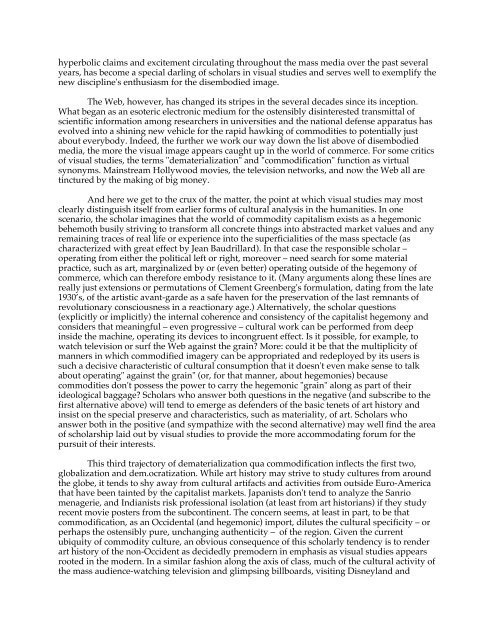Chapter Thirty Visual Culture/Visual Studies
Chapter Thirty Visual Culture/Visual Studies
Chapter Thirty Visual Culture/Visual Studies
Create successful ePaper yourself
Turn your PDF publications into a flip-book with our unique Google optimized e-Paper software.
hyperbolic claims and excitement circulating throughout the mass media over the past several<br />
years, has become a special darling of scholars in visual studies and serves well to exemplify the<br />
new discipline's enthusiasm for the disembodied image.<br />
The Web, however, has changed its stripes in the several decades since its inception.<br />
What began as an esoteric electronic medium for the ostensibly disinterested transmittal of<br />
scientific information among researchers in universities and the national defense apparatus has<br />
evolved into a shining new vehicle for the rapid hawking of commodities to potentially just<br />
about everybody. Indeed, the further we work our way down the list above of disembodied<br />
media, the more the visual image appears caught up in the world of commerce. For some critics<br />
of visual studies, the terms "dematerialization" and "commodification" function as virtual<br />
synonyms. Mainstream Hollywood movies, the television networks, and now the Web all are<br />
tinctured by the making of big money.<br />
And here we get to the crux of the matter, the point at which visual studies may most<br />
clearly distinguish itself from earlier forms of cultural analysis in the humanities. In one<br />
scenario, the scholar imagines that the world of commodity capitalism exists as a hegemonic<br />
behemoth busily striving to transform all concrete things into abstracted market values and any<br />
remaining traces of real life or experience into the superficialities of the mass spectacle (as<br />
characterized with great effect by Jean Baudrillard). In that case the responsible scholar –<br />
operating from either the political left or right, moreover – need search for some material<br />
practice, such as art, marginalized by or (even better) operating outside of the hegemony of<br />
commerce, which can therefore embody resistance to it. (Many arguments along these lines are<br />
really just extensions or permutations of Clement Greenberg's formulation, dating from the late<br />
1930’s, of the artistic avant-garde as a safe haven for the preservation of the last remnants of<br />
revolutionary consciousness in a reactionary age.) Alternatively, the scholar questions<br />
(explicitly or implicitly) the internal coherence and consistency of the capitalist hegemony and<br />
considers that meaningful – even progressive – cultural work can be performed from deep<br />
inside the machine, operating its devices to incongruent effect. Is it possible, for example, to<br />
watch television or surf the Web against the grain? More: could it be that the multiplicity of<br />
manners in which commodified imagery can be appropriated and redeployed by its users is<br />
such a decisive characteristic of cultural consumption that it doesn't even make sense to talk<br />
about operating" against the grain" (or, for that manner, about hegemonies) because<br />
commodities don't possess the power to carry the hegemonic "grain" along as part of their<br />
ideological baggage? Scholars who answer both questions in the negative (and subscribe to the<br />
first alternative above) will tend to emerge as defenders of the basic tenets of art history and<br />
insist on the special preserve and characteristics, such as materiality, of art. Scholars who<br />
answer both in the positive (and sympathize with the second alternative) may well find the area<br />
of scholarship laid out by visual studies to provide the more accommodating forum for the<br />
pursuit of their interests.<br />
This third trajectory of dematerialization qua commodification inflects the first two,<br />
globalization and dem.ocratization. While art history may strive to study cultures from around<br />
the globe, it tends to shy away from cultural artifacts and activities from outside Euro-America<br />
that have been tainted by the capitalist markets. Japanists don't tend to analyze the Sanrio<br />
menagerie, and Indianists risk professional isolation (at least from art historians) if they study<br />
recent movie posters from the subcontinent. The concern seems, at least in part, to be that<br />
commodification, as an Occidental (and hegemonic) import, dilutes the cultural specificity – or<br />
perhaps the ostensibly pure, unchanging authenticity – of the region. Given the current<br />
ubiquity of commodity culture, an obvious consequence of this scholarly tendency is to render<br />
art history of the non-Occident as decidedly premodern in emphasis as visual studies appears<br />
rooted in the modern. In a similar fashion along the axis of class, much of the cultural activity of<br />
the mass audience-watching television and glimpsing billboards, visiting Disneyland and







